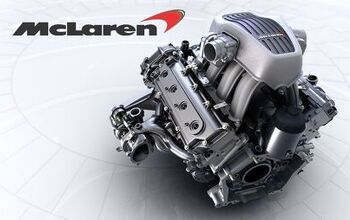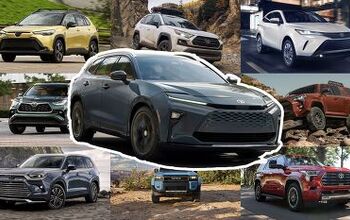Everything You Need to Know About the First Turbocharged Ferrari Engine in Decades

The Geneva Motor Show always plays host to a throng of exciting ultra-high-performance automobiles and this year’s installment was no exception. Lamborghini revealed its sultry new Huracán, McLaren unwrapped the alluring 650S and even Pagani’s outlandish Zonda Revolución made a showing. But the folks in Maranello, Italy were not to be out done.
Ferrari’s new California T bowed in the French-speaking Swiss city. This drop-top GT car features a number of significant enhancements over its predecessor. It’s been restyled, gains a new steering box as well as updated magnetorheological dampers that supposedly react 50 percent faster than the units supporting today’s version of the car. But all these reforms are just icing on the cake; the California T’s biggest news is in the engine compartment.
The car is powered by a brand-new 3.8-liter V8 that features a duet of exhaust-driven blowers; it’s the first turbocharged Ferrari in literally decades.
This engineering masterpiece delivers a 552 hp stampede along with 523 lb-ft of torque. With a seven-speed dual-clutch transmission, the California T can sprint from zero to 100 km/h in a claimed 3.6 seconds. But just because this engine is turbo-boosted doesn’t mean it can’t spin freely; redline is a lofty 7,500 rpm. Making a delicious combination even sweeter the car is approximately 15 percent more fuel efficient than its predecessor.
Magnificence Is Not Happenstance
To learn more about this exciting powerplant we didn’t mess around, instead we went straight to the man in charge, one of Maranello’s magicians. Roberto Fideli is technical director at Ferrari and he graciously sat down with us for an in-depth interview.
Sequestered from the din and buzzing energy of the Geneva Motor Show, Fideli walked us through the ins and outs of this force-fed powerplant.
From day one, the company had three distinct goals in mind while developing this engine; it had to be efficient, sound like a Ferrari and deliver razor-sharp throttle response, plus it still had to provide supercar performance.
SEE ALSO: 2014 Geneva Motor Show Coverage
“We had a very big challenge because we were very happy about natural-aspired engines and we had a lot of ideas to develop natural-aspired engines,” Fideli explained. However, due to increasingly stringent fuel-economy and emissions regulations a classic Ferrari engine with lots of cubic inches (or centimeters) and a mile-high redline wouldn’t cut it in this application. A combination of downsized displacement and turbo boost was the answer. Fideli said “we think that this is the only technology that will allow us to do it without losing power and torque,” that is, to deliver an appropriate driving experience along with reduced fuel consumption.
“If we don’t find out a technical solution we can’t go in the market with a product that’s not our product” said Fideli; it took them quite a long time to get everything just right.
Efficiency
All told this new V8, which was about five years in the making, features a number of fuel-saving technologies, some of which are found on run-of-the-mill powerplants from mainstream manufacturers and others that are unique to Ferrari.
Direct fuel injection boosts efficiency and performance, as does a coating on the car’s octet of pistons. Up in the cylinder head roller-finger followers transfer motion from all four camshafts to the valves while minimizing frictional losses; this is the same high-performance valvetrain setup used in other Ferrari engines.
Curiously the bumpstick-drive assembly is mounted at the rear of the powerplant instead of up front like on many other mills. Interestingly this design choice was all about practicality and had nothing to do with going fast. Fideli said “[It’s] only for packaging; there is no reason specifically for performance,” though undoubtedly this move helps keep the California T’s hood low and lean, for a menacing appearance and improved aerodynamics.
Topside once again, the engine sports a signature Ferrari intake assembly. The high-tumble manifold setup features near-vertical runners for a straight shot directly into the combustion chambers. Of course the major components of this system are coated in a sizzling-red, wrinkle-finish; the same vivacious hue is carried over on the cam covers to great effect.
Another classic trait is buried deep in the engine’s basement. The Italian brand is known for its widespread use of flat-plane crankshafts and there’s no deviation here. Fideli said “it’s normal for Ferrari engines.” Compared to the more common cross-plane design this piece of work is both lower in mass and more compact, attributes that result in better performance and efficiency, not to mention a characteristic howling exhaust note.
SEE ALSO: 2013 Lamborghini Gallardo Five-Point Inspection
While we’re down in the cellar it’s worth mentioning the block. The alloy foundation supports an oversquare cylinder arrangement; the bore clocks in at 3.41 inches, the stoke just 3.23. As for compression, the ratio is deceptively low at just 9.4-to-one, though that’s just fine for a forced-induction engine where cylinder pressures can get pretty hairy when the boost comes up.
Sound
“For us it is not a choice, for us it is a must, to have the right sound together with the right power and torque” Fideli said, the second of their three main engineering objectives with this brand-new twin-turbo V8. Accordingly the engine should call the faithful to worship like a church bell on Sunday mornings.
With turbines, catalytic converters and complicated plumbing, turbo engines aren’t often known for their acoustic qualities; they often sound choked or muffled. But this was not an option with the California T.
In order to preserve the engine’s robust timbre engineers developed complex three-piece exhaust manifolds that plumb spent combustion gasses to the turbos. He called this layout a “completely crazy solution” but one that works.
“For the sound we invented a very complicated exhaust system where all the pipes, eight pipes, starting from the cylinder up to the turbo have exactly the same length.” Going on he noted “in this way only the pure orders of the engine, second order, fourth order, eighth order, sixteenth order are coming out, and the other orders are destroyed because of the length.” Translation: the force-fed California T promises to sound like a true Italian exotic.
Responsiveness
“And the third concern that we had was the evolution… the shape of the torque curve over the revs” Fideli said. Continuing he noted that “normally when you think about a turbo you can have a very flat torque curve, but for us it is very important to maintain the characteristic of a Ferrari engine with the shape of the torque curve where the torque is increasing over the revs.”
Of course even with a billiard-table flat torque curve a vehicle will still accelerate, but it won’t necessarily feel like it’s surging ahead. Ford’s 2.0-liter EcoBoost four-cylinder engine comes to mind. It kicks hard at low- and mid-range speeds but seems to run out of steam in the upper rev range. This sort of twist delivery is great for everyday driving but it’s not appropriate for a Ferrari.
Fideli explained “you have to feel something that is pushing more and more and more [the faster you drive].” He also said “the force is increasing over the revs; it’s not constant,” which pushes you back into the seat and makes it feel like you’re a bullet exiting the muzzle of a gun. He also noted that you don’t necessarily feel like you’re accelerating with a flat torque curve (take that, Tesla!).
Further increasing responsiveness is the above-mentioned low-inertia crankshaft as well as twin-scroll turbos, but that’s not all. Fideli said “the shape of the torque curve was obtained by adapting and personalizing the torque curve for each gear.” What this means is that the powertrain-control module can adjust output in each ratio to deliver the desired performance. If a driver is cruising along back roads, zipping down the highway or going all-out while negotiating a racetrack the car should respond appropriately and seamlessly.
Maranello’s been out of the turbo game for years but the engine they’ve developed for the redesigned California T is a fascinating piece of engineering. Features including its three-piece exhaust manifolds, flat-plane crankshaft and upright intake plumbing are unique in the automotive industry but pure Ferrari. Added efficiency is always appreciated and the car ought to deliver a combined consumption score of 10.5 L/100 km on the combined European test cycle. Directly converted that works out to about 22.4 mpg U.S., but keep in mind these scores really can’t be compared because the drive cycles are different.
With 552 hp on tap and nearly as much torque it looks like the California T will surprise and delight customers with its exciting new powertrain. And that was a major objective of the program. Fideli said “for me the main goal is that a Ferrari owner is not understanding that this engine is a turbo engine. He is feeling that the engine is doing what he wants in every condition of driving. This is my goal.”
GALLERY: Ferrari California T Engine
GALLERY: Ferrari California T Live Photos
GALLERY: Ferrari California T
Discuss this story on our luxury-lifestyle forum

Born and raised in metro Detroit, Craig was steeped in mechanics from childhood. He feels as much at home with a wrench or welding gun in his hand as he does behind the wheel or in front of a camera. Putting his Bachelor's Degree in Journalism to good use, he's always pumping out videos, reviews, and features for AutoGuide.com. When the workday is over, he can be found out driving his fully restored 1936 Ford V8 sedan. Craig has covered the automotive industry full time for more than 10 years and is a member of the Automotive Press Association (APA) and Midwest Automotive Media Association (MAMA).
More by Craig Cole

































Comments
Join the conversation
Everything I wanted to know except the only thing I really wanted to know and that is price ?
Nice, but still girl's car...